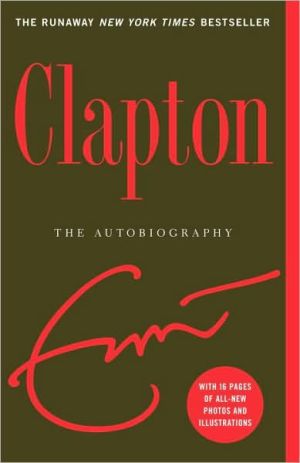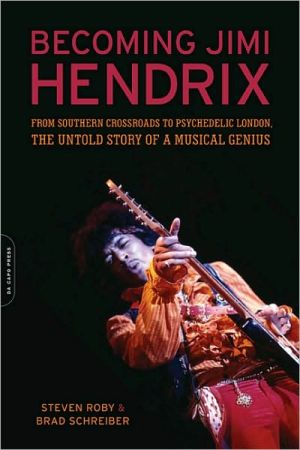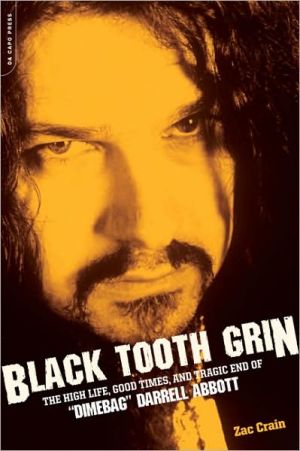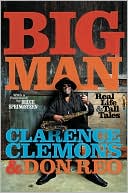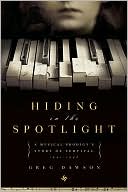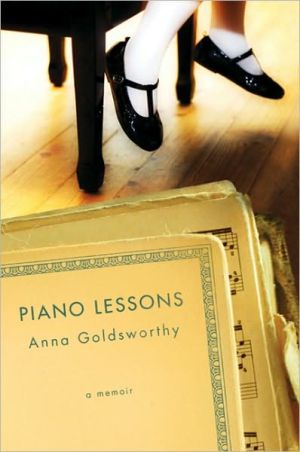Clapton: The Autobiography
"I found a pattern in my behavior that had been repeating itself for years, decades even. Bad choices were my specialty, and if something honest and decent came along, I would shun it or run the other way."\ With striking intimacy and candor, Eric Clapton tells the story of his eventful and inspiring life in this poignant and honest autobiography. More than a rock star, he is an icon, a living embodiment of the history of rock music. Well known for his reserve in a profession marked by...
Search in google:
Eric Clapton is far more than a rock star. Like Dylan and McCartney he is an icon and a living legend. He has sold tens of millions of records, played sell-out concerts all over the world and been central to the significant musical developments of his era. His guitar playing has seen him hailed as 'God'. Tracks such as Layla, Sunshine Of Your Love,Wonderful Tonight and Tears In Heaven have become anthems for generations of music fans. Now for the first time, Eric tells the story of his personal and professional journeys in this pungent, witty and painfully honest autobiography.Eric was born illegitimate in 1945 and raised by his grandparents. He never knew his father and until the age of nine believed his absentee mother to be his sister. In his teens his solace was the guitar and he soon became a cult hero in the club circuits of Britain. With the foundation of the world's first super group Cream in 1966 he became a world superstar.But the rock star lifestyle has had a da... The Barnes & Noble Review "Clapton Is God," wrote the London graffiti artists in the '60s; if the message wasn't strictly accurate, it was more concise than "Eric Clapton is the leading innovator of blues-based lead guitar in rock 'n' roll." In Clapton: The Autobiography, our guitar-hero narrator confesses to some youthful ambivalence about this praise, before allowing that he thought it was "really quite nice."
Clapton\ The Autobiography \ \ By Eric Clapton \ Broadway\ Copyright © 2007 Eric Clapton\ All right reserved.\ ISBN: 9780385518512 \ \ \ Growing Up\ \ \ Early in my childhood, when I was about six or seven, I began to get the feeling that there was something different about me. Maybe it was the way people talked about me as if I weren’t in the room. My family lived at 1, the Green, a tiny house in Ripley, Surrey, which opened directly onto the village Green. It was part of what had once been almshouses and was divided into four rooms; two poky bedrooms upstairs, and a small front room and kitchen downstairs. The toilet was outside, in a corrugated iron shed at the bottom of the garden, and we had no bathtub, just a big zinc basin that hung on the back door. I don’t remember ever using it.\ \ Twice a week my mum used to fill a smaller tin tub with water and sponge me down, and on Sunday afternoons I used to go and have a bath at my Auntie Audrey’s, my dad’s sister, who lived in the new flats on the main road. I lived with Mum and Dad, who slept in the main bedroom overlooking the Green, and my brother, Adrian, who had a room at the back. I slept on a camp bed, sometimes with my parents, sometimes downstairs, depending on who was staying at the time. The house had no electricity, and the gas lamps made a constant hissing sound. It amazes me now to think that whole familieslived in these little houses.\ \ My mum had six sisters: Nell, Elsie, Renie, Flossie, Cath, and Phyllis, and two brothers, Joe and Jack. On a Sunday it wasn’t unusual for two or three of these families to show up, and they would pass the gossip and get up–to–date with what was happening with us and with them. In the smallness of this house, conversations were always being carried on in front of me as if I didn’t exist, with whispers exchanged between the sisters. It was a house full of secrets. But bit by bit, by carefully listening to these exchanges, I slowly began to put together a picture of what was going on and to understand that the secrets were usually to do with me. One day I heard one of my aunties ask, “Have you heard from his mum?” and the truth dawned on me, that when Uncle Adrian jokingly called me a little bastard, he was telling the truth.\ \ The full impact of this realization upon me was traumatic, because at the time I was born, in March 1945—in spite of the fact that it had become so common because of the large number of overseas soldiers and airmen passing through England—an enormous stigma was still attached to illegitimacy. Though this was true across the class divide, it was particularly so among working–class families such as ours, who, living in a small village community, knew little of the luxury of privacy. Because of this, I became intensely confused about my position, and alongside my deep feelings of love for my family there existed a suspicion that in a tiny place like Ripley, I might be an embarrassment to them that they always had to explain.\ \ The truth I eventually discovered was that Mum and Dad, Rose and Jack Clapp, were in fact my grandparents, Adrian was my uncle, and Rose’s daughter, Patricia, from an earlier marriage, was my real mother and had given me the name Clapton. In the mid–1920s, Rose Mitchell, as she was then, had met and fallen in love with Reginald Cecil Clapton, known as Rex, the dashing and handsome, Oxford–educated son of an Indian army officer. They had married in February 1927, much against the wishes of his parents, who considered that Rex was marrying beneath him. The wedding took place a few weeks after Rose had given birth to their first child, my uncle Adrian. They set up home in Woking, but sadly, it was a short–lived marriage, as Rex died of consumption in 1932, three years after the birth of their second child, Patricia.\ \ Rose was heartbroken. She returned to Ripley, and it was ten years before she was married again, after a long courtship on his part, to Jack Clapp, a master plasterer. They were married in 1942, and Jack, who as a child had badly injured his leg and therefore been exempt from call–up, found himself stepfather to Adrian and Patricia. In 1944, like many other towns in the south of England, Ripley found itself inundated with troops from the United States and Canada, and at some point Pat, age fifteen, enjoyed a brief affair with Edward Fryer, a Canadian airman stationed nearby. They had met at a dance where he was playing the piano in the band. He turned out to be married, so when she found out she was pregnant, she had to cope on her own. Rose and Jack protected her, and I was born secretly in the upstairs back bedroom of their house on March 30, 1945. As soon as it was practical, when I was in my second year, Pat left Ripley, and my grandparents brought me up as their own child. I was named Eric, but Ric was what they all called me.\ \ Rose was petite with dark hair and sharp, delicate features, with a characteristic pointed nose, “the Mitchell nose,” as it was known in the family and which was inherited from her father, Jack Mitchell. Photographs of her as a young woman show her to have been very pretty, quite the beauty among her sisters. But at some point at the outset of the war, when she had just turned thirty, she underwent surgery for a serious problem with her palate. During the operation there was a power cut that resulted in the surgery having to be abandoned, leaving her with a massive scar underneath her left cheekbone that gave the impression that a piece of her cheek had been hollowed out. This left her with a certain amount of self-consciousness. In his song “Not Dark Yet,” Dylan wrote, “Behind every beautiful face there’s been some kind of pain.” Her suffering made her a very warm person with a deep compassion for other people's dilemmas. She was the focus of my life for much of my upbringing.\ \ Jack, her second husband and the love of her life, was four years younger than Rose. A shy, handsome man, over six feet tall with strong features and very well built, he had a look of Lee Marvin about him and used to smoke his own roll–ups, made from a strong, dark tobacco called Black Beauty. He was authoritarian, as fathers were in those days, but he was kind, and very affectionate to me in his way, especially in my infant years. We didn’t have a very tactile relationship, as all the men in our family found it hard to express feelings of affection or warmth. Perhaps it was considered a sign of weakness. Jack made his living as a master plasterer, working for a local building contractor. He was a master carpenter and a master bricklayer, too, so he could actually build an entire house on his own.\ \ An extremely conscientious man with a very strong work ethic, he brought in a very steady wage, which didn’t ever fluctuate for the whole time I was growing up, so although we could have been considered poor, we rarely had a shortage of money. When things occasionally did get tight, Rose would go out and clean other people’s houses, or work part–time at Stansfield’s, a bottling company with a factory on the outskirts of the village that produced fizzy drinks such as lemonade, orangeade, and cream soda. When I was older I used to do holiday jobs there, sticking on labels and helping with deliveries, to earn pocket money. The factory was like something out of Dickens, reminiscent of a workhouse, with rats running around and a fierce bull terrier that they kept locked up so it wouldn’t attack visitors.\ \ Ripley, which is more like a suburb today, was deep in the country when I was born. It was a typical small rural community, with most of the residents being agricultural workers, and if you weren’t careful about what you said, then everybody knew your business. So it was important to be polite. Guildford was the main shopping town, which you could get to by bus, but Ripley had its own shops, too. There were two butchers, Conisbee’s and Russ’s, and two bakeries, Weller’s and Collins’s, a grocer’s, Jack Richardson’s, Green’s the paper shop, Noakes the ironmonger, a fish–and–chip shop, and five pubs. King and Olliers was the haberdashers where I got my first pair of long trousers, and it doubled as a post office, and we had a blacksmith where all the local farm horses came in for shoes.\ \ Every village had a sweet shop; ours was run by two old-fashioned sisters, the Miss Farrs. We would go in there and the bell would go ding–a–ling–a–ling, and one of them would take so long to come out from the back of the shop that we could fill our pockets up before a movement of the curtain told us she was about to appear. I would buy two Sherbert Dabs or a few Flying Saucers, using the family ration book, and walk out with a pocketful of Horlicks or Ovaltine tablets, which had become my first addiction.\ \ In spite of the fact that Ripley was, all in all, a happy place to grow up in, life was soured by what I had found out about my origins. The result was that I began to withdraw into myself. There seemed to have been some definite choices made within my family regarding how to deal with my circumstances, and I was not made privy to any of them. I observed the code of secrecy that existed in the house—“We don’t talk about what went on”—and there was also a strong disciplinarian authority in the household, which made me nervous about asking any questions. On reflection, it occurs to me that the family had no real idea of how to explain my own existence to me, and that the guilt attached to that made them very aware of their own shortcomings, which would go a long way in explaining the anger and awkwardness that my presence aroused in almost everybody. As a result I attached myself to the family dog, a black Labrador called Prince, and created a character for myself, whose name was “Johnny Malingo.” Johnny was a suave, devil–may–care man/boy of the world who rode roughshod over anyone who got in his way. I would escape into Johnny when things got too much for me, and stay there until the storm had passed. I also invented a fantasy friend called Bushbranch, a small horse who went with me everywhere. Sometimes Johnny would magically become a cowboy and climb onto Bushbranch, and together they would ride off into the sunset. At the same time, I started to draw quite obsessively. My first fascination was with pies. A man used to come to the village Green pushing a barrow, which was his container for hot pies. I had always loved pies—Rose was an excellent cook—and I produced hundreds of drawings of them and of the pie man. Then I turned to copying from comics.\ \ Because I was illegitimate, Rose and Jack tended to spoil me. Jack actually made my toys for me. I remember, for example, a beautiful sword and shield that he made me by hand. It was the envy of all the other kids. Rose bought me all the comics I wanted. I seemed to get a different one every day, always The Topper, The Dandy, The Eagle, and The Beano. I particularly loved the Bash Street Kids, and I always used to notice when the artists would change and Lord Snooty’s top hat would be different in some way. Over the years I copied countless drawings from these comics—cowboys and Indians, Romans, gladiators, and knights in armor. Sometimes at school I did no classwork at all, and it became quite normal to see all of my textbooks full of nothing but drawings.\ \ School for me began when I was five, at Ripley Church of England Primary School, which was situated in a flint building next to the village church. Opposite was the village hall, where I attended Sunday school, and where I first heard a lot of the old, beautiful English hymns, my favorite of which was “Jesus Bids Us Shine.” At first I was quite happy going to school. Most of the kids who lived on the Green next to us started at the same time, but as the months went by, and it dawned on me that this was it for the long haul, I began to panic. The feelings of insecurity I had about my home life made me hate school. All I wanted to be was anonymous, which kept me out of entering any kind of competitive event. I hated anything that would single me out and get me unwanted attention.\ \ I also felt that sending me to school was just a way of getting me out of the house, and I became very resentful. One master, quite young, a Mr. Porter, seemed to have a real interest in unearthing the children's gifts or skills, and becoming acquainted with us in general. Whenever he tried this with me, I would become extremely resentful. I would stare at him with as much hatred as I could muster, until he eventually caned me for what he called “dumb insolence.” I don’t blame him now; anyone in a position of authority got that kind of treatment from me. Art was the only subject that I really enjoyed, though I did win an award for playing “Greensleeves” on the recorder, which was the first instrument I ever learned to play.\ \ The headmaster, Mr. Dickson, was a Scotsman with a shock of red hair. I had very little to do with him until I was nine years old, when I was called up before him for making a lewd suggestion to one of the girls in my class. While playing on the Green, I had come across a piece of homemade pornography lying in the grass. It was a kind of book, made of pieces of paper crudely stapled together with rather amateurish drawings of genitalia and a typed text full of words I had never heard of. My curiosity was aroused because I hadn’t had any kind of sex education, and I had certainly never seen a woman’s genitalia. In fact, I wasn't even certain if boys were different from girls until I saw this book.\ \ Once I recovered from the shock of seeing these drawings, I was determined to find out about girls. I was too shy to ask any of the girls I knew at school, but there was this new girl in class, and because she was new, it was open season on her. As luck would have it, she was put at the desk directly in front of me in the classroom, so one morning I plucked up courage and asked her, without any idea of what the words meant, “Do you fancy a shag?” She looked at me with a bemused expression, because she obviously didn’t have a clue what I was talking about, but at playtime she went and told another girl what I’d said, and asked what it meant. After lunch I was summoned to the headmaster’s office, where, after being quizzed as to exactly what I had said to her and being made to promise to apologize, I was bent over and given six of the best. I left in tears, and the whole episode had a dreadful effect on me, as from that point on I tended to associate sex with punishment, shame, and embarrassment, feelings that colored my sexual life for years. \ \ Continues... \ \ \ \ Excerpted from Clapton by Eric Clapton Copyright © 2007 by Eric Clapton. Excerpted by permission.\ All rights reserved. No part of this excerpt may be reproduced or reprinted without permission in writing from the publisher.\ Excerpts are provided by Dial-A-Book Inc. solely for the personal use of visitors to this web site. \ \
Growing Up 3The Yardbirds 27John Mayall 55Cream 71Blind Faith 97Derek and the Dominds 115Lost Years 133461 Ocean Boulevard 145El and Nell 159The End of the Road 183Hazelden: Picking up the Pieces 197Relapse 211Conor 229The Aftermath 247Crossroads 261Melia 275A Family Man 289A Year on the Road 305Epilogue 323Acknowledgments 329Inder 331Photo Credits 343
\ From Barnes & NobleHe never knew his father. He was past 9 when he was finally told that his "older sister" was actually his mother. Shy and moody, he communicated little with his family or peers. For his 13th birthday, he received an acoustic guitar. At first, the gift was a source of irritation. Then he began what would become thousands of hours of practice…. The autobiography of Eric Clapton is far more than the story of how one lonely boy became the greatest rock guitarist in history. It is the memoir of a man who somehow survived all his bad choices.\ \ \ \ \ Stephen KingMost A.A. meetings begin with the chairman offering his qualifications at the head table next to the coffee maker. This qualification is more commonly known in the program as the drunkalogue. It's a good word, with its suggestions of inebriated travel, and it certainly fits Eric Clapton's account of his life. Clapton is nothing so literary as a memoir, but its dry, flat-stare honesty makes it a welcome antidote to the macho fantasies of recovery served up by James Frey in A Million Little Pieces…Clapton is honest—sometimes, as in the account of his son's death, even searing—and often witty, with a hard-won survivor's humor…He may not have the skill of a Mary Karr or Frank McCourt, but I'm sure he writes better than most memoirists play guitar. And sometimes the workmanlike flashes into the wonderful, as when he describes himself in his early days as "a green young scholar listening my way forward."\ —The New York Times\ \ \ Elliott VanskikeThe articulate, thoughtful rock-and-roller faces a dilemma when he sits down to write his autobiography. Does he give fans what they've come to expect by wallowing in the excesses of sex and drugs? Or does he write an intelligent, reflective book that actually assesses his life in the spotlight? Eric Clapton's autobiography leaves little doubt that he lived the rock-and-roll lifestyle, but there's hardly a trashed hotel room or sordid tryst to be found here. Chastened by his experience as a recovering alcoholic, Clapton writes in a restrained, self-critical, even humble mode.\ —The Washington Post\ \ \ \ \ Publishers WeeklyClapton's heartfelt memoir is given the perfect gift in its reader: acclaimed actor and fellow Brit Bill Nighy (Pirates of the Caribbean; Love, Actually). Nighy reads Clapton's tender, dignified remembrance of his legendary career as if it had all truly happened to him. He is simply a cut above the run-of-the-mill reader and ably handles the unvarnished first-person recounting of Clapton's rise to fame, his struggles with addiction and relationship problems, and his return to sobriety and musical success. Clapton picks through the wreckage of his past, including the tragic death of his son, Conor, and Nighy reads with vigor and restraint. Clapton's tone is apologetic and nostalgic, and Nighy admirably conveys both sentiments. Joining the two together is an audio match made in heaven. Simultaneous release with the Broadway Books hardcover (Reviews, Aug. 20). (Oct.)\ Copyright 2007 Reed Business Information\ \ \ \ \ Library JournalGuitar wizard Clapton bares his soul in a starkly honest first attempt at autobiography. Beginning with his childhood in rural Ripley, England, he describes growing up with his grandparents who led him to believe they were his parents, his mother's reappearance with a husband and two children, and her subsequent disappearance. Clapton relates his discovery of sexuality after reading a handmade pornographic comic book on the school-yard playground, which led to a thrashing from the headmaster and years of sexual dysfunction. He chronicles his liberation from confusion and loneliness through music, especially a purist version of the American blues, which resulted in stints with the Yardbirds and John Mayall. Retracing his ascent to stardom with Cream, Blind Faith, and then his solo career, Clapton also recounts his struggles with addiction, first with heroin and then his major 15-year battle with alcohol. He writes of the loss of his son and his destructive relationships with women, ending the book with his new life of sobriety with his wife, Melia, and his daughters. This bold, intimate, and revealing look at an icon of rock 'n' roll will satisfy all readers, especially his myriad fans. Highly recommended. [See Prepub Alert, LJ6/1/07.]\ —Dave Szatmary\ \ \ \ \ \ Kirkus ReviewsThe celebrated rock guitarist pens an uneven yet engrossing memoir. Clapton has enjoyed a colorful and eventful career for four decades, and he has long been among the most reticent of interview subjects, so the English axeman's autobiography is cause for some celebration. The book will aggravate those who want to know more about the nuts and bolts of his long-lasting stardom, though he dutifully, if somewhat perfunctorily, marches through his musical history. Born illegitimate in rural Surrey and raised by his grandparents, Clapton became a blues fanatic and took up guitar as a youth. Barely in his 20s, he found immediate fame as a wizardly soloist in a succession of storied bands: the Yardbirds, John Mayall's Bluesbreakers, Cream, Blind Faith and Derek & The Dominos. The ever-hesitant Clapton still appears uneasy about delving too deeply into the dynamics of these legendary groups, though here and there he offers an amusing backstage anecdote or a penetrating glimpse of such bandmates as drummer Ginger Baker and keyboardist Steve Winwood, or contemporaries like Jimi Hendrix and John Lennon. His tale is most compelling, and his narrative voice strongest, when he writes about the vicissitudes of his romantic life and his protracted struggle with heroin addiction and alcoholism. He emotionally replays his agonizing affair and long, rocky relationship with Pattie Boyd, George Harrison's wife when he met her, and he is bluntly honest about the years he lost to junk and drink before he finally sobered up for good 20 years ago. Clapton is also movingly candid about the accidental death of his son Conor in 1991. His account of the founding of his Antiguan drug-and-alcohol facility Crossroadspowerfully affirms the guitarist's commitment to recovery. The book peters out in its last pages, as Clapton muses on marital commitment and late-life parenthood. Weakest on musical recollections and career arcs, but some overwhelmingly poignant and wrenching personal meditations make the book a success.\ \ \ \ \ The Barnes & Noble ReviewClapton Is God, wrote the London graffiti artists in the '60s; if the message wasn't strictly accurate, it was more concise than "Eric Clapton is the leading innovator of blues-based lead guitar in rock 'n' roll." In Clapton: The Autobiography, our guitar-hero narrator confesses to some youthful ambivalence about this praise, before allowing that he thought it was "really quite nice."\ Those three words typify the diffident tone of Clapton's memoir. When he remembers acclaim, it's bashfully. When he describes the various ways in which he made a disaster of his life, he sounds rueful rather than wracked with grief. Given Clapton's status as one of our most stoic rock stars -- he rarely unburdens himself in interviews -- the detailed history in this book will make it essential for Clapton worshippers and a pleasant surprise for casual readers.\ Clapton may have been valorized by at least some of those graffiti writers for the wrong reason: his sheer instrumental virtuosity. One unfortunate side effect of his career is the notion that guitar wankery is heroic, culminating with such dubious rock icons as Steve Vai and Yngwie Malsteen. But unlike many of his successors, Clapton learned lessons from blues music that extended beyond guitar prowess, and pursued mastery in both singing and writing songs. That's what let him sustain a connection with the public across the decades, even if fans thought they were just genuflecting at the feet of a guitar god. Compare Clapton with the nimble-fingered Jeff Beck, who followed him as the Yardbirds' guitarist, and who, similarly, was never able to stay with one group for long. Beck, however, needed a vocal foil like Rod Stewart, and is now more vaguely admired than loved.\ One version of Clapton's life is the musical odyssey from passionate young innovator to a self-styled "journeyman" churning out pop mush to a dignified third act as an aging bluesman. But the central narrative of this book is Clapton's battle with addiction: He spent years using heroin, and then moved on to alcohol. His art was marked by his virtuosity and control; his personal life, he makes clear, was where everything got messy. Clean today, he has devoted some serious personal resources to building treatment centers for alcoholism.\ Clapton is clear-eyed about many of his bad choices and their consequences: Describing his junkie lifestyle, he writes, "The doors remained closed, the post went unopened, and we existed on a diet of chocolate and junk food, so I soon became not only overweight, but spotty and generally unfit. Heroin also completely took away my libido, so we had no sexual activity of any kind, and I became chronically constipated."\ He's less forthright about some other aspects of his life, not addressing, for example, his decision to endorse Michelob while struggling with alcoholism. He also glosses over his years-long support for British anti-immigrant politician Enoch Powell as quickly as possible, deploying a rapid-fire series of excuses, pleading the effect of drink on some of his public statements and defending himself against charges of racism by asserting (for example) his sympathy with the plight of Jamaican immigrants, and mentioning that his girlfriend "had just been leered at by a member of the Saudi royal family."\ Clapton has apparently been keeping a diary for at least some portion of his life; no coauthor is credited on The Autobiography, which reads smoothly if a touch blandly. (It presumably wasn't Clapton, however, who thought it was a good idea to add parenthetical notes for American readers explaining that "quid" means "pounds" and "crisps" are known to us as "potato chips.")\ Clapton: The Autobiography is at its most vivid when he's describing road trips: the inside of the van he rode around in with John Mayall's Bluesbreakers (Mayall built himself a bunk bed); a hippie adventure across Europe with a pickup band called the Glands (they got so hungry in Greece, they ate raw meat at a butcher shop); a whirlwind trip to Canada to play a rock festival with John Lennon (when they arrived at the Toronto airport, Lennon and Yoko Ono jumped into a limousine, leaving the rest of the band to travel with the luggage in a van).\ At times, Clapton's prose can devolve into a dull list of British blues musicians. Better are the sections that unearth quirky details about his family, such as his uncle's invention of a vinegar dispenser that he could hide inside his clothing, with a tube coming down the sleeve. And Clapton deftly evokes the unique intellectual horizons of the 1960s, when Baudelaire and Tolkien seemed equally mind-expanding to him.\ Perhaps the most emotionally potent aspect of the book deals with the great passion of Clapton's life (other than blues music), the fashion model Pattie Boyd. Boyd was married to his good friend George Harrison -- the Beatle who, like Clapton, was more comfortable expressing himself with a guitar than in conversation. "I think initially I was motivated by a mixture of lust and envy, but it all changed once I got to know her," Clapton writes. He wooed Boyd away from Harrison in 1974; they married in 1979 and divorced in 1989.\ The Boyd/Harrison/Clapton triangle has become one of the mythic tales of rock -- not because it was particularly unusual for rock stars of the era to tumble in and out of each other's beds but because Clapton wrote one of the greatest rock songs ever, "Layla," about Boyd and his then-unrequited love for her.\ As it happens, Boyd has published her own memoir, Wonderful Tonight (named for another song Clapton wrote for her -- there are many more, including "Bell Bottom Blues," inspired by some jeans he brought her from Miami). Public interest in one of rock's greatest muses hasn't flagged -- the book hit No. 1 on the New York Times bestseller list.\ It's not often that two books about a love affair that ended almost two decades ago come out within weeks of each other, and it provides a rare opportunity to play rock 'n' roll Rashomon, comparing the two accounts. Clapton and Boyd agree on most major points (allowing for some details being a touch fuzzy due to the passage of time and the prodigious amounts of drugs and booze they were consuming), but the differences are telling.\ Some of the variances are just things that it's easier to judge from outside. While Clapton remembers that he won a school prize for "neatness and tidiness" (!), it falls to Boyd to report that as an adult, Clapton "was not a naturally tidy man.... The bedroom carpet was lamb's wool, and filthy, and the bath was full of his sweaters and shirts -- that was where he stored them."\ Clapton is fuzzy on exactly when and how he began seriously pursuing Boyd, but she can pinpoint it: a passionate letter in the spring of 1970 "in small, immaculate writing, with no capital letters." Assuming it was from a crazed Beatles fan, she initially laughed it off, even showing it to Harrison.\ They both say that Clapton ended up giving her an ultimatum: If she didn't leave Harrison for him, he would become a heroin addict. "He did as he threatened," Boyd says. But Clapton makes it clear that he was just bluffing: "In truth, of course, I had been taking [heroin] almost full-time for quite a while."\ Clapton didn't treat Boyd well, they agree. Aside from the cruelty of telling a loved one that your heroin addiction is her fault, once he had successfully wooed her, he almost immediately started screwing around (bedding, among others, his backup singer Yvonne Elliman, who went on to have a No. 1 single in 1977 with the Barry Gibb composition "If I Can't Have You").\ One of the most arresting turns of phrase in Clapton: The Autobiography concerns the state of Harrison and Boyd's marriage, which had become rocky after the Beatles returned from studying with the Maharishi in India: "[T]hey were living in virtual open warfare at Friar Park, with him flying the 'Om' flag at one end of the house and her flying a Jolly Roger at the other."\ Wonderful Tonight, however, makes it clear that this is not metaphor, but (slightly mangled) fact: When Boyd found out Harrison was shagging Ringo Starr's wife, Maureen, she went to the top of the house and hauled down her husband's "Om" banner in favor of a skull and crossbones. Three decades down the road, it seems Boyd is still Clapton's greatest inspiration. --Gavin Edwards\ Gavin Edwards is a regular contributor to Rolling Stone and Wired, among other publications and is the author of books including Is Tiny Dancer Really Elton's Little John?\ \ \
